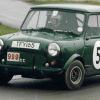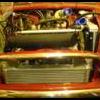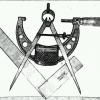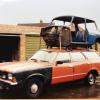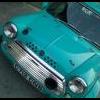
Crank And Cam
#1

Posted 04 August 2018 - 12:43 PM
Thanks in advance,
Will
#2

Posted 04 August 2018 - 12:51 PM
Hi,
Can't see why not
The MG metro cam used to be a favourite among the turbo guys...
Cheers ![]()
#3

Posted 04 August 2018 - 01:05 PM
Hi,
Can't see why not
The MG metro cam used to be a favourite among the turbo guys...
Cheers
Cheers Bat, so would you say get a metro cam but that the crank should be fine to use?
#4

Posted 04 August 2018 - 01:30 PM
The 10/10 crank should be fine providing you are not going for 150hp
The SPi cam is a bit short on inlet timing and has extended exhaust timing
MG metro cams are good, but in fairly short supply, the MS evolution001 is not far off the MG, its new and value for money when compared to a 2nd hand MG cam which has done how many revs...a MD266 or the milder 256 could also be useful for the road
#5

Posted 04 August 2018 - 01:43 PM
The 10/10 crank should be fine providing you are not going for 150hp
The SPi cam is a bit short on inlet timing and has extended exhaust timing
MG metro cams are good, but in fairly short supply, the MS evolution001 is not far off the MG, its new and value for money when compared to a 2nd hand MG cam which has done how many revs...a MD266 or the milder 256 could also be useful for the road
Thank you! I'll do a bit of research on the cam
#6

Posted 04 August 2018 - 05:17 PM
Hi,
You don't want anything wild as it will just take longer to spool up the turbo.
As you're pushing the air in rather than hoping the engine will suck it in, the cam can be one with low overlap.
Cheers ![]()
#7

Posted 04 August 2018 - 05:30 PM
Edited by mini13, 04 August 2018 - 05:30 PM.
#8

Posted 24 November 2018 - 02:27 PM
Hi WillCarter,
With any turbo application on any engine, you generally want to reduce the overlap as much as possible*
Turbo's work on pressure differential, meaning to get the thing to spin up, you need more pressure in front of it than behind. What this means is, if you go for a wild(er) NA cam, during the overlap period the excess pressure in the exhaust manifold wants to flow back into the cylinder. This presents a couple of problems. You now have hot/dirty air contaminating the clean charge coming into the cylinder which increases the likelihood of pinging (hence part of the reason why some guys tend to run fatter mixtures with turbos... for the cooling effect). The second issue is that it takes longer to spool up due to wasted potential manifold pressure and increased reversion. If you look at (for example) a kent MD296, the timing figures are 39-71/44-76... so on this cam you have 83 degrees worth of overlap where exhaust gases are trying to pour back into the cylinder. On an NA engine, that overlap can be made useful because it aids scavenging but on a turbo engine its not helpful at all.
Your best 3 options are; (1) run a standard cam with high lift rockers.. this will still improve flow without adding overlap (2) Find a specific turbo cam with minimal overlap (3) as a lot of guys have done in the past, get a good moderate road cam, and find a cam grinder who can grind it for you with a wider LSA to decrease the overlap (as the lobe centre lines are spread apart from each other, it decrease the time that both valves are open together... eg. increasing from 106 to 118 would decrease overlap by 12 degrees).
*The exception to this, SOME modern turbo designs which are more efficient do not require the same amount of head pressure to start spinning. In the past it wasn't uncommon to see pressure ratios of 2:1 from front to rear, now days with SOME set ups you can actually achieve 1:1. In these instances you have a lot more freedom with cam choices.
Hope that helps, or at least confuses you enough to ask more questions LOL
Edited by AKat, 24 November 2018 - 11:29 PM.
#9

Posted 26 November 2018 - 02:00 PM
Hi WillCarter,
With any turbo application on any engine, you generally want to reduce the overlap as much as possible*
Turbo's work on pressure differential, meaning to get the thing to spin up, you need more pressure in front of it than behind. What this means is, if you go for a wild(er) NA cam, during the overlap period the excess pressure in the exhaust manifold wants to flow back into the cylinder. This presents a couple of problems. You now have hot/dirty air contaminating the clean charge coming into the cylinder which increases the likelihood of pinging (hence part of the reason why some guys tend to run fatter mixtures with turbos... for the cooling effect). The second issue is that it takes longer to spool up due to wasted potential manifold pressure and increased reversion. If you look at (for example) a kent MD296, the timing figures are 39-71/44-76... so on this cam you have 83 degrees worth of overlap where exhaust gases are trying to pour back into the cylinder. On an NA engine, that overlap can be made useful because it aids scavenging but on a turbo engine its not helpful at all.
Your best 3 options are; (1) run a standard cam with high lift rockers.. this will still improve flow without adding overlap (2) Find a specific turbo cam with minimal overlap (3) as a lot of guys have done in the past, get a good moderate road cam, and find a cam grinder who can grind it for you with a wider LSA to decrease the overlap (as the lobe centre lines are spread apart from each other, it decrease the time that both valves are open together... eg. increasing from 106 to 118 would decrease overlap by 12 degrees).
*The exception to this, SOME modern turbo designs which are more efficient do not require the same amount of head pressure to start spinning. In the past it wasn't uncommon to see pressure ratios of 2:1 from front to rear, now days with SOME set ups you can actually achieve 1:1. In these instances you have a lot more freedom with cam choices.
Hope that helps, or at least confuses you enough to ask more questions LOL
Thanks AKat, I'll see about finding a standard cam. The build's on hold at the moment but I'll probably have a load of questions once it's underway again. Cheers!
#10

Posted 26 November 2018 - 02:12 PM
Hi WillCarter,
With any turbo application on any engine, you generally want to reduce the overlap as much as possible*
Turbo's work on pressure differential, meaning to get the thing to spin up, you need more pressure in front of it than behind. What this means is, if you go for a wild(er) NA cam, during the overlap period the excess pressure in the exhaust manifold wants to flow back into the cylinder. This presents a couple of problems. You now have hot/dirty air contaminating the clean charge coming into the cylinder which increases the likelihood of pinging (hence part of the reason why some guys tend to run fatter mixtures with turbos... for the cooling effect). The second issue is that it takes longer to spool up due to wasted potential manifold pressure and increased reversion. If you look at (for example) a kent MD296, the timing figures are 39-71/44-76... so on this cam you have 83 degrees worth of overlap where exhaust gases are trying to pour back into the cylinder. On an NA engine, that overlap can be made useful because it aids scavenging but on a turbo engine its not helpful at all.
Your best 3 options are; (1) run a standard cam with high lift rockers.. this will still improve flow without adding overlap (2) Find a specific turbo cam with minimal overlap (3) as a lot of guys have done in the past, get a good moderate road cam, and find a cam grinder who can grind it for you with a wider LSA to decrease the overlap (as the lobe centre lines are spread apart from each other, it decrease the time that both valves are open together... eg. increasing from 106 to 118 would decrease overlap by 12 degrees).
*The exception to this, SOME modern turbo designs which are more efficient do not require the same amount of head pressure to start spinning. In the past it wasn't uncommon to see pressure ratios of 2:1 from front to rear, now days with SOME set ups you can actually achieve 1:1. In these instances you have a lot more freedom with cam choices.
Hope that helps, or at least confuses you enough to ask more questions LOL
wowzers - first post, and no messin' about !
welcome aboard AKat
Edited by KTS, 26 November 2018 - 02:12 PM.
#11

Posted 26 November 2018 - 10:28 PM
Good info above. Also bear in mind that although high lift rockers don't increase overlap they do increase lift at any given point, so this includes lift at overlap, hence why people don't often see the gains they expected when using them in a forced induction application especially where a small turbo is used.
Basically the less restrictive the turbine the more "cam" can be used.
Phil.
#12

Posted 27 November 2018 - 09:51 AM
Hi,
From what I know of YB cosworth engines the spi cam with short inlet and longer exhaust durations should be ideal.
Short inlet is fine as the air is forced in and the longer exhaust will let all the extra exhaust gas out.
If you think about it if you put 1 bar of boost in you've effectively doubled your engines air capacity, so 1275cc becomes 2550cc. So now you have all that extra exhaust gas to get rid of and a turbine in the way...
Cheers ![]()
Edited by Bat, 27 November 2018 - 09:53 AM.
#13

Posted 30 November 2018 - 11:36 AM
That's a good point Phil, at any point the lift is higher, even during overlap. While lift and duration both impact flow, they're not interchangeable. Even though the lift is higher during the overlap period, it doesn't increase the time that the cylinder is exposed to manifold back pressure. The time its exposed remains the same, although through a larger window. If you're comparing a standard cam with 25 to 30 degrees of overlap to even a mild NA cam with 50 degrees of overlap, the reversion effects are still going to be worse with the cam that has 50 degrees overlap than one with half that because of time exposure ![]()
The good ol' YB, it was amazing how all those turbo Group A engines exploded onto the scene in the 80's. DJR out here in Australia was getting a over 600hp out of his RS touring car in the late 80's, absolutely mind blowing out of a 2.0 liter. You could do worse than to follow Keith Duckworth's examples.
When you're trying to compare cams between engines, it is extremely important to consider the engines you're talking about. An Austin A series is under square and has bloody long rod ratio of 1.91 on a 998 or 1.79 on a 1275, and has 2 valves per cylinder fed by a head that by all rights is better described as a water heater than an engine component... a YB on the other had is Over Square, has a reasonably normal rod ratio of 1.67, has 4 valves per cylinder fed by a head that good that it was more or less copied by Japanese manufacturers for the next 20 years.
The reason these things are important is that it will totally change the requirements of the cam profile. Rod ratio alone will effect peak piston velocity, piston acceleration, the point of peak velocity, and how long it spends at max velocity. This alone changes pressure drop and where the pressure drop occurs. Comparing a YB to an A series, a YB reaching peak velocity from 73 to 75 degrees with velocity changing only by decimal points.... An A Series on the other hand maxes out later at 76 Degrees and doesn't hold peak velocity, just flashes passed it.
The cylinder heads.. ![]()
Back it up a sec.... Just like I said before, the thing that makes a turbo spin is pressure differential.... the thing that fills an engine is also pressure differential... High pressure, flows to low pressure.... And as velocity increase, density decreases.... Pressure is the thing that changes that air speed... and Pressure (p) is
P = F/A
Force applied to an area...
The smaller the area for the same force the greater the pressure, or, pressure differential. If you're talking about an NA engine then force is 14.7psi atmospheric pressure.. Another simple way to describe pressure is "Resistance to flow"... So when you compare a free flowing well designed - ACTUALLY designed head to a water heater obviously the flow restrictions are going to be different, and as a result the port speeds and port energies are going to be different. The end result is the cylinder charge densities will be different for the same cam timing and lift.
Long winded - but that's why you gotta compare apples to apples (hard to do when there isn't a lot like the A series out there ![]() )
)
The other thing as well is that dual pattern cams are common, always have been... interesting thing, a lot of cam grinders actually give longer duration on intakes than exhausts for turbo applications, again to combat reversion. The other side effect is that it forces the turbo to act like a kind of scavenging pump for blowing the exhaust out (if you've ever seen a 2 Stroke diesel you'll know what I'm talking about lol ).
At the end of the day, the cam needs to be right for the engine its going to be used in
Edited by AKat, 30 November 2018 - 01:15 PM.
1 user(s) are reading this topic
0 members, 1 guests, 0 anonymous users




